This list will seem noticeably familiar to many. And that appears to be the point. If there ever was a primal scene for Romanticism and theory, especially in the way it was staged within North America, the 1970s would be the name for it. Explicitly confronting or implicitly shadowboxing with that decade’s critical disposition still colors our critical endeavors more than forty years afterward, from New Historicism in the 1980s to contemporary interventions of the New Materialisms and the Affective Turn. That said, the periodizing use of the 1970s was for me a heuristic as much as anything else, a way to get a partial handle on the rhizomatic weave presented to anyone trying to parse intelligently the idea of listing the key texts for Romanticism and theory. The same goes for particularizing the narrative in terms of its North American settings—hence the inclusion of the 1974 U.S. publication of De La Grammatologie (1967) and the non-inclusion of Phillipe Lacoue-Labarthe and Jean Luc-Nancy’s L’Absolu Litteraire (1978) whose first U.S. publication as The Literary Absolute was in1988. Likewise, someone else might envision this same list in a very different way, making room for publications that throughout the decade familiarized the Frankfurt School with English speaking audiences—works whose theorizing on art and politics would in coming years add their own distinct say to the question of how Romanticism and theory interact. Similarly, theorizing the historical dimensions of terms like the “country” or “literature” in Romantic studies we’d necessarily have to turn to Raymond Williams’s The Country and the City (1973) and Marxism and Literature (1977). So this is really just a start in the multi-verse that we can call Romanticism and Theory.
Romanticism and Consciousness: Essays in Criticism (New York: W.W.W. Norton, 1970)
Authored by Harold Bloom
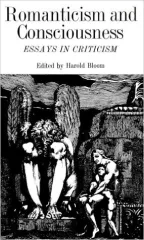
A diverse yet potent summation of the equation of Romanticism as mind versus world that arguably fueled much of the critical interest behind Romanticism’s mid-century ascendancy into the higher spheres of academic study after its Modernist disapprobations. Romanticism and Consciousness also provides one generative blueprint for how Romanticism and theory relate, insofar as the very attempt to define Romanticism brings the critic into the realm of what increasingly and reflexively begins to call itself theory. A particular genre in itself, this effort often seems attracted to the compact suppleness of the essay form, of which the pieces in Romanticism and Consciousness all partake. Especially of note, Bloom’s “The Internalization of Quest-Romance” and Hartman’s “Romanticism and ‘Anti-Self Consciousness’” teeter on the edge or limits of a phenomenological-inspired criticism, with de Man’s “Intentional Structure of the Romantic Image” in slow motion taking us over the cliff.
Natural Supernaturalism: Tradition and Revolution in Romantic Literature (New York: W.W.W. Norton, 1971)
Authored by M. H. Abrams
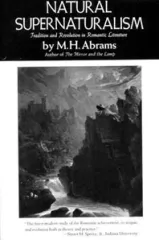
Like Romanticism and Consciousness, Natural Supernaturalism stands as an apotheosis to a kind of theoretical interrogation, and definition, of Romanticism that in retrospect was also the announcement of its passing. One could argue that the focus on the Romantic mind in Romanticism and Consciousness still has an insurgent power, either as a starting point for the application of cognitive science to literary texts or as a shibboleth that various forms of speculative realism and object-oriented criticism want again to banish. In contrast, the totalizing encyclopedic form of Natural Supernaturalism as itself a synthesizing expression of Romantic being seems, along with its humanist values, entrenched in the past, simply a marker for the different kinds of critiques that surpassed it. Yet in its assumptions and practice of a totalizing historical identity Natural Supernaturalism does exemplify the particular theoretical Romantic question of the relation between method and object of study. This book could also well yield new perspectives for scholars currently interested in the ways systems and systematic thought were part of the Romantic topos. As an unapologetic history of ideas it continues to ask us what history is, and the book’s Romantic pivot from a theological to secular world reminds us of one abiding theoretical point of departure for the study of Romanticism, its relation to modernity.
Blindness and Insight: Essays in the Rhetoric of Contemporary Criticism (Minneapolis: University of Minnesota Press, 1971)
Authored by Paul de Man
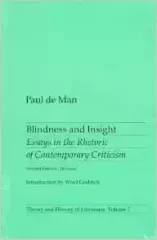
First published the same year as Natural Supernaturalism to an equal amount of critical attention, and showing an alike familiarity with a comparative method cohering around works from English and Continental literature—have any two works so vividly demarcated a set of opposing choices about not only the meaning of Romanticism but also the very intent of humanistic inquiry? If the Romanticism in Natural Supernaturalism employed a neo-Hegelian dialectic committed to a stadial warding off of loss, Blindness and Insight begins the careful practice of meta-reading that in de Man’s later writings will explicitly announce itself as a recording of not only the radical blockage of any such ameliorating narrative but also of the dialectic itself. The Romantic character of this bifurcating set of critical choices is all the more striking given how much of Blindness and Insight is slanted towards the interface between twentieth-century literary criticism and Modernist writers. For Romanticists, however, this book is especially synonymous with two key essays. “The Rhetoric of Blindness: Jacques Derrida’s Reading of Rousseau” provides us with a mise en abyme of a paper trail that stages through the Romantic topos of Rousseau the transformation of reading, or literary criticism, into theory. “The Rhetoric of Temporality” is essential for anyone interested in the topic of this list, or in the study of Romanticism, for that matter. Vertiginously delineating the critical turn from the phenomenal to the linguistic, “The Rhetoric of Temporality” models the meanings of theory as a provocation or intervention, including in no small way the question of the (dis)continuity between Romanticism and Romanticist.
The Anxiety of Influence: A Theory of Poetry (New York: Oxford University Press, 1973)
Authored by Harold Bloom
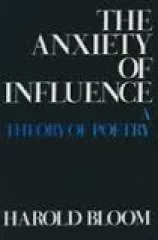
Fittingly, The Anxiety of Influence functions as something of an outlier in this list, given Bloom’s own reflexively idiosyncratic response to the arguments of his cohort then, as well as to the academic community at large, throughout his entire career. While his six revisionary ratios never gained any real traction as part of the critical lexicon, the overarching themes of The Anxiety of Influence enabled a host of crucial critical writings, including both major historicist and feminist revisions of Bloom’s own argument, one that really can’t be thought apart from Bloom’s understanding of Romanticism. In its own way The Anxiety of Influence also, along with the writings of Hartman, ensured that an engagement with Freud would be part of future readings involving Romanticism and theory, especially given de Man’s own non-interest in psychoanalysis. Separate from the question of Bloom’s own influence, in its brevity and singular nature this book reads now as something akin to a critical prose poem. Or, perhaps even more unnervingly, if this language can be used, as pure poetry.
Of Grammatology (Baltimore: Johns Hopkins University Press, 1974)
Authored by Jacques Derrida; Translated by Gayatri Spivak
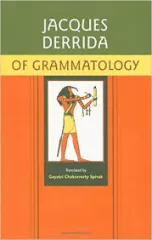
No other text exemplifies that strange sense of overwhelming familiarity, alien promise, and constant threat that accompanies the writing of an event. For our purposes it’s worth reminding ourselves how much that sense is generated by the book’s sections on reading Rousseau, the presumed avatar of Romantic interiority and expression. In some fundamental way both Derrida’s écriture and de Man’s allegory of reading come from an encounter with Rousseau, and thus with Romanticism.
Allegories of Reading: Figural Language in Rousseau, Nietzsche, Rilke, and Proust (New Haven: Yale University Press, 1979)
Authored by Paul de Man
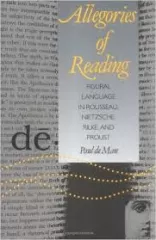
In the collection, The Rhetoric of Romanticism (1984), de Man explicitly says that none of the pieces in Allegories of Reading are about Romanticism. One could use Allegories of Reading to see de Man’s thought originating in a Modernist habitus of literary experimentation and figural reflexivity. Yet just as it’s impossible for a Romanticist not to know what happens between Derrida and Rousseau in Of Grammatology, no student of Romanticism can avoid an encounter with the Rousseaus that are read in Allegories of Reading. The range of works by Rousseau that de Man explores in this book emphatically expands the themes and issues that become part of the topos of theorizing Romanticism’s texts. Arguably, the centrality of Rousseau in Allegories of Reading also anticipates the historicist 1980s positioning of Rousseau over Milton as the key influence and precursor to English Romanticism. Even if de Man is correct about the non-relation between Allegories of Reading and Romanticism, that would still beg the question of what the Rousseaus in that text mean to any Romanticist committed to the conceptual force of the long eighteenth century. More fundamentally, it’s hard not to understand the non-cognitive, non-phenomenal proposition of the allegory of reading as also outlining what’s at stake in a slew of Romantic texts, if not Romanticism itself.
Deconstruction and Criticism (New York and London: Continuum, 1979)
Authored by Harold Bloom, et al.
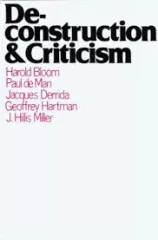
As inventive as any critical collaboration or artistic mashup, this collection started with the premise of having Bloom, de Man, Derrida, Hartman and Miller separately read Shelley’s The Triumph of Life, though Bloom and Hartman soon go their own way, choosing Ashbery and Wordsworth instead. The collection is best known for de Man’s “Shelley Disfigured,” an exacting piece of epistemic violence that, as time passes, only increasingly affirms its role as that kernel of radical negativity that the contemporary, corporate academy of techno-administrative outcomes can neither absorb nor digest. That said, it’s difficult to imagine any attentive reader not being entranced by other moments in this collection, such as what Hartman does with Wordsworth’s ear in “Words, Wish, Worth: Wordsworth.” If there is any truth to the notion of deconstruction as simply an institutionalized creation of 1970s academic theater, Deconstruction and Criticism is the major text for that performance piece, with Romanticism via Shelley at the heart of it.
“‘Like a Guilty Thing Surprised’: Deconstruction, Coleridge, and the Apostasy of Criticism,” Critical Inquiry 12 (Summer 1986): 769-87
Authored by Jerome Christensen

Published in the mid-1980s and explicitly focusing on the events of the late 1960s in relation to a Romanticism built around a political and linguistic awareness of apostasy in Burke and Coleridge, Christensen’s brilliant essay would seem to sidestep the 1970s altogether. In fact, ‘“Like a Guilty Thing Surprised”’ is a quintessential example of a piece of writing committed to thinking through what it means to write in the wake of the 1970s encounter between Romanticism and theory. In doing so, Christensen models a link between Romanticism and theory that is as intrinsic as it is volatile, ongoing, and timely.
Theory at Yale: The Strange Case of Deconstruction in America(New York, Fordham University Press, 2016)
Authored by Marc Redfield
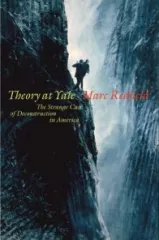
Lucid, erudite, and theoretically sophisticated, Redfield’s study is an able guide for readers wanting to confront in depth the critical energies unleashed by a number of the books on this list. The virtue of Theory at Yale lies not only in its expert handling of its archives, but in its understanding that the explanatory dimensions of such treatment constitute a theoretical wager. Elaborating the true significance of a number of the Yale Critics’ relation to Romanticism, Redfield writes that, “As a collective, they were able to personify aesthetic-theoretical excess” (10). That’s just one of the clarifying, unsettling formulations awaiting readers of Redfield’s book.
